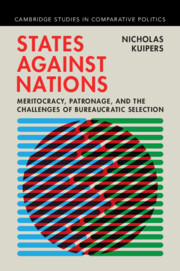Refine search
Actions for selected content:
281 results
On the selection of subaction and measure for perturbed potentials
- Part of
-
- Journal:
- Ergodic Theory and Dynamical Systems , First View
- Published online by Cambridge University Press:
- 17 December 2025, pp. 1-35
-
- Article
- Export citation
2 - The Species-Specifics of Thriving
- from Part I - Thriving
-
- Book:
- Animal Curation
- Published online:
- 20 November 2025
- Print publication:
- 04 December 2025, pp 38-49
-
- Chapter
- Export citation
Chapter 9 - Twenty Questions about Employment Testing Bias and Unfairness in Greece
-
-
- Book:
- Global Perspectives on the Definition, Assessment, and Reduction of Bias and Unfairness in Employment Testing
- Published online:
- 04 November 2025
- Print publication:
- 20 November 2025, pp 184-198
-
- Chapter
- Export citation
Chapter 15 - Twenty Questions about Employment Testing Bias and Unfairness in Nigeria
-
-
- Book:
- Global Perspectives on the Definition, Assessment, and Reduction of Bias and Unfairness in Employment Testing
- Published online:
- 04 November 2025
- Print publication:
- 20 November 2025, pp 304-316
-
- Chapter
- Export citation
9 - Description
-
- Book:
- The Prompts You Need to Help You Write the Book You Want to Write
- Published online:
- 25 October 2025
- Print publication:
- 06 November 2025, pp 108-123
-
- Chapter
- Export citation
6 - Dancing in the Dark
-
- Book:
- Applied Healthcare Economics
- Published online:
- 26 September 2025
- Print publication:
- 16 October 2025, pp 100-148
-
- Chapter
- Export citation

States against Nations
- Meritocracy, Patronage, and the Challenges of Bureaucratic Selection
-
- Published online:
- 14 August 2025
- Print publication:
- 07 August 2025
10 - Legitimacy and International Rights Holding
- from Part IV - Construction of Legitimacy in International Law
-
- Book:
- The Law and Politics of International Legitimacy
- Published online:
- 14 July 2025
- Print publication:
- 24 July 2025, pp 173-201
-
- Chapter
- Export citation
The relation between head movement and periphrasis
-
- Journal:
- Journal of Linguistics , First View
- Published online by Cambridge University Press:
- 23 June 2025, pp. 1-28
-
- Article
-
- You have access
- Open access
- HTML
- Export citation
Chapter 5 - English Historical Sociolinguistics
-
- Book:
- English Sociolinguistics
- Published online:
- 01 May 2025
- Print publication:
- 15 May 2025, pp 119-153
-
- Chapter
- Export citation
Risk, time pressure, and selection effects
-
- Journal:
- Experimental Economics / Volume 22 / Issue 1 / 15 March 2019
- Published online by Cambridge University Press:
- 14 March 2025, pp. 216-246
-
- Article
-
- You have access
- Open access
- HTML
- Export citation
Escalation in conflict games: on beliefs and selection
-
- Journal:
- Experimental Economics / Volume 23 / Issue 3 / September 2020
- Published online by Cambridge University Press:
- 14 March 2025, pp. 750-787
-
- Article
-
- You have access
- Open access
- HTML
- Export citation
For those about to talk we salute you: an experimental study of credible deviations and ACDC
-
- Journal:
- Experimental Economics / Volume 17 / Issue 2 / June 2014
- Published online by Cambridge University Press:
- 14 March 2025, pp. 173-199
-
- Article
- Export citation
Increases in trust and altruism from partner selection: Experimental evidence
-
- Journal:
- Experimental Economics / Volume 11 / Issue 2 / June 2008
- Published online by Cambridge University Press:
- 14 March 2025, pp. 134-153
-
- Article
- Export citation
Chapter 1 - The Household: Size, Gender, and Recruitment
- from Part I - The People of the Household
-
- Book:
- Ladies-in-Waiting in Medieval England
- Published online:
- 02 January 2025
- Print publication:
- 09 January 2025, pp 35-80
-
- Chapter
- Export citation
Errata for “The Proper Sequence for Correcting Correlation Coefficients for Range Restriction and Unreliability”
-
- Journal:
- Psychometrika / Volume 66 / Issue 4 / December 2001
- Published online by Cambridge University Press:
- 01 January 2025, pp. 593-594
-
- Article
-
- You have access
- Export citation
Using the Criterion-Predictor Factor Model to Compute the Probability of Detecting Prediction Bias with Ordinary Least Squares Regression
-
- Journal:
- Psychometrika / Volume 77 / Issue 3 / July 2012
- Published online by Cambridge University Press:
- 01 January 2025, pp. 561-580
-
- Article
- Export citation
On the Geometric Approach to Multivariate Selection
-
- Journal:
- Psychometrika / Volume 49 / Issue 3 / September 1984
- Published online by Cambridge University Press:
- 01 January 2025, pp. 383-390
-
- Article
- Export citation
Fisher Transformations for Correlations Corrected for Selection and Missing Data
-
- Journal:
- Psychometrika / Volume 58 / Issue 4 / December 1993
- Published online by Cambridge University Press:
- 01 January 2025, pp. 601-615
-
- Article
- Export citation
Measurement Invariance, Factor Analysis and Factorial Invariance
-
- Journal:
- Psychometrika / Volume 58 / Issue 4 / December 1993
- Published online by Cambridge University Press:
- 01 January 2025, pp. 525-543
-
- Article
- Export citation
